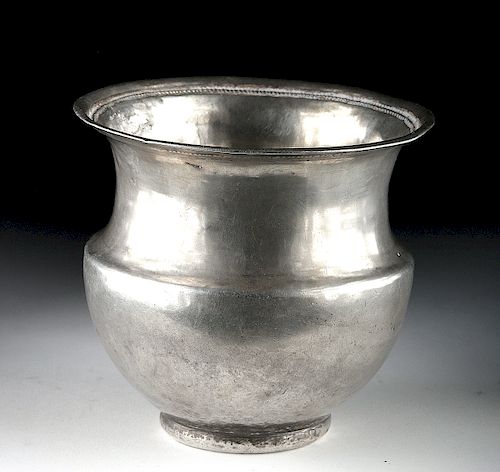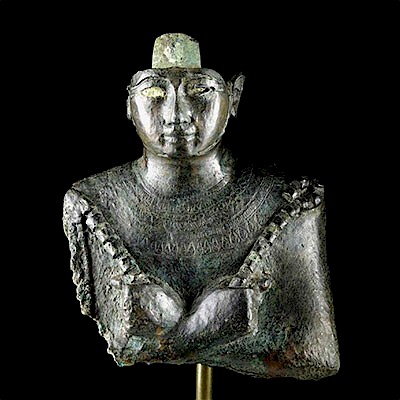Greek Hellenistic Silver Vessel, ex-Christie's
Lot 39
About Seller
Artemis Fine Arts
686 S Taylor Ave, Ste 106
Louisville, CO 80027
United States
Selling antiquities, ancient and ethnographic art online since 1993, Artemis Gallery specializes in Classical Antiquities (Egyptian, Greek, Roman, Near Eastern), Asian, Pre-Columbian, African / Tribal / Oceanographic art. Our extensive inventory includes pottery, stone, metal, wood, glass and textil...Read more
Estimate:
$8,000 - $12,000
Absentee vs Live bid
Two ways to bid:
- Leave a max absentee bid and the platform will bid on your behalf up to your maximum bid during the live auction.
- Bid live during the auction and your bids will be submitted real-time to the auctioneer.
Bid Increments
| Price | Bid Increment |
|---|---|
| $0 | $25 |
| $300 | $50 |
| $1,000 | $100 |
| $2,000 | $250 |
| $5,000 | $500 |
| $10,000 | $1,000 |
| $20,000 | $2,500 |
| $50,000 | $5,000 |
| $100,000 | $10,000 |
| $200,000 | $20,000 |
About Auction
By Artemis Fine Arts
May 22, 2019
Set Reminder
2019-05-22 10:00:00
2019-05-22 10:00:00
America/New_York
Bidsquare
Bidsquare : Exceptional Day 1: Antiquities Asian Fine Art
https://www.bidsquare.com/auctions/artemis-gallery/exceptional-day-1-antiquities-asian-fine-art-4129
Day 1 of an important 2-day auction featuring exceptional art from around the world - Egyptian, Greek, Etruscan, Roman, Viking, Russian, Near Eastern; Asian Art from China, Japan, Thailand, Vietnam, Burma, India; Fine Art from the 17th century to present. Artemis Fine Arts info@artemisgallery.com
Day 1 of an important 2-day auction featuring exceptional art from around the world - Egyptian, Greek, Etruscan, Roman, Viking, Russian, Near Eastern; Asian Art from China, Japan, Thailand, Vietnam, Burma, India; Fine Art from the 17th century to present. Artemis Fine Arts info@artemisgallery.com
- Lot Description
Greece, late Hellenistic Period, ca. late 2nd to 1st century BCE. An elegant cup formed from a hammered sheet of nearly-pure (99%) silver. The vessel is defined by a hemispherical body atop a slightly-concave discoid foot, a gently-corseted cylindrical neck, carinated shoulders, and an outsplayed rim decorated along the interior with a ring of bead-form molding in repousse. During the Hellenistic period, wealthy Greeks used silver as a marker of wealth more often than they had in the past. During the 5th century BCE, a new silver source was discovered in the Laurium Hills in Attica, which was extensively mined soon thereafter. The profits from the mines enriched several Athenian families and created a greater pool of silver with which artisans could produce fine goods like this cup. Size: 4.25" W x 4" H (10.8 cm x 10.2 cm); quality of silver: 99%; total weight: 245.0 grams.
For a stylistically-similar example with additional body detailing from the early Hellenistic Period, please see The Metropolitan Museum of Art, accession number 1972.118.159: https://www.metmuseum.org/art/collection/search/255470
Provenance: private East Coast, USA collection; ex-Christie's, New York Antiquities auction (sale 3748, June 4, 2015, lot 43); ex-William Froelich collection, New York, USA, acquired in 1991 from Boris Mussienko, Upper Marlboro, Maryland, USA
All items legal to buy/sell under U.S. Statute covering cultural patrimony Code 2600, CHAPTER 14, and are guaranteed to be as described or your money back.
A Certificate of Authenticity will accompany all winning bids.
We ship worldwide and handle all shipping in-house for your convenience.
#145883Repair and possible restoration to area just beneath lip. Slight indentations to body and neck, light softening to molded motifs with encrustations within recessed areas, and light abrasions across most surfaces. Light earthen deposits and fine patina throughout.Condition
- Shipping Info
-
All shipping is handled in-house for your convenience. Your invoice from Artemis Gallery will include shipping calculation instructions. If in doubt, please inquire BEFORE bidding for estimated shipping costs for individual items.
-
- Buyer's Premium



 EUR
EUR CAD
CAD AUD
AUD GBP
GBP MXN
MXN HKD
HKD CNY
CNY MYR
MYR SEK
SEK SGD
SGD CHF
CHF THB
THB
















